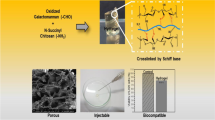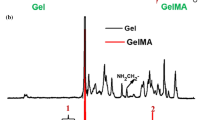Abstract
Carboxymethylchitosan (CMCS) was prepared in a strong alkaline mixture system of isopropyl alcohol and water, and the substitution degrees of carboxymethylation on -OH and –NH2 groups of chitosan were 58% and 5%, respectively. A series of hydrogels were obtained by mixing 1 wt%-5 wt% aqueous solution of CMCS with aldehyde-4-arm polyethylene glycol (4r-PEG-CHO) and ZnCl2 at room temperature at pH=6. The presence of a chemical and physical cross linker in the same time, 4r-PEG-CHO and ZnCl2, enhanced the mechanical properties of hydrogels and the storage modulus of the gels reached up to 1562 Pa. This may be due to a synergistic effect of imine bonds, metal coordination and hydrogen bonding. The hydrogels exhibited good injectability, pH sensitivity and rapid self-healing ability. Macroscopic observation and dynamic rheological results showed that the hydrogels could self-heal within 1 min after being damaged. This novel rapid self-healing injectable hydrogel has potential applications in the field of biomedicine.










Similar content being viewed by others
Data availability
The raw/processed data required to reproduce these findings cannot be shared at this time as the data also forms part of an ongoing study.
References
Jafari A, Hassanajili S, Azarpira N, Bagher Karimi M, Geramizadeh B (2019) Development of thermal-crosslinkable chitosan/maleic terminated polyethylene glycol hydrogels for full thickness wound healing: in vitro and in vivo evaluation. Eur Polym J 118:113–127. https://doi.org/10.1016/j.eurpolymj.2019.05.046
Xuan H, Wu S, Fei S, Li B, Yang Y, Yuan H (2021) Injectable nanofiber-polysaccharide self-healing hydrogels for wound healing. Mat Sci Eng C 128:112264. https://doi.org/10.1016/j.msec.2021.112264.
Deng P, Yao L, Chen J, Tang Z, Zhou J (2022) Chitosan-based hydrogels with injectable, self-healing and antibacterial properties for wound healing. Carbohydr Polym 276:118718. https://doi.org/10.1016/j.carbpol.2021.118718.
Qin D, Zhang A, Wang N, Yao Y, Chen X, Liu Y (2022) Hydroxybutyl chitosan/ oxidized glucomannan self-healing hydrogels as bmscs-derived exosomes carriers for advanced stretchable wounds. Appl Mater Today 26:101342. https://doi.org/10.1016/j.apmt.2021.101342.
Buranachai T, Praphairaksit N, Muangsin N (2010) Chitosan/polyethylene glycol beads crosslinked with tripolyphosphate and glutaraldehyde for gastrointestinal drug delivery. Aaps Pharmscitech 11(3):1128–1137. https://doi.org/10.1208/s12249-010-9483-z
Jing ZW, Ma ZW, Li C, Jia YY, Luo M, Ma XX, Zhou SY, Zhang BL (2017) Chitosan cross-linked with poly(ethylene glycol)dialdehyde via reductive amination as effective controlled release carriers for oral protein drug delivery. Bioorg Med Chem Lett 27(4):1003–1006. https://doi.org/10.1016/j.bmcl.2016.12.072
Naeimi M, Tajedin R, Farahmandfar F, Naeimi M, Monajjemi M (2020) Preparation and characterization of vancomycin-loaded chitosan/pva/peg hydrogels for wound dressing. Mater Res Express 7(9):95401. https://doi.org/10.1088/2053-1591/abb154
Fu B, Cheng B, Bao X, Wang Z, Shangguan Y, Hu Q (2019) Self-healing and conductivity of chitosan-based hydrogels formed by the migration of ferric ions. J Appl Polym Sci 136(34):47885. https://doi.org/10.1002/app.47885
Thomas J, Sharma A, Panwar V, Chopra V, Ghosh D (2019) Polysaccharide-based hybrid self-healing hydrogel supports the paracrine response of mesenchymal stem cells. Acs Appl Bio Mater 2(5):2013–2027. https://doi.org/10.1021/acsabm.9b00074
Huang W, Wang Y, Chen Y, Zhao Y, Zhang Q, Zheng X, Chen L, Zhang L (2016) Strong and rapidly self-healing hydrogels: potential hemostatic materials. Adv Healthc Mater 5(21):2813–2822. https://doi.org/10.1002/adhm.201600720
Song F, Kong Y, Shao C, Cheng Y, Lu J, Tao Y, Du J, Wang H (2021) Chitosan-based multifunctional flexible hemostatic bio-hydrogel. Acta Biomater 136:170–183. https://doi.org/10.1016/j.actbio.2021.09.056
Yang Y, Xu L, Wang J, Meng Q, Zhong S, Gao Y, Cui X (2022) Recent advances in polysaccharide-based self-healing hydrogels for biomedical applications. Carbohydr Polym 283:119161. https://doi.org/10.1016/j.carbpol.2022.119161.
Rasool A, Ata S, Islam A (2019) Stimuli responsive biopolymer (chitosan) based blend hydrogels for wound healing application. Carbohydr Polym 203:423–429. https://doi.org/10.1016/j.carbpol.2018.09.083
Quan L, Xin Y, Wu X, Ao Q (2022) Mechanism of self-healing hydrogels and application in tissue engineering. Polymers 14(11):2184. https://doi.org/10.3390/polym14112184
Qu J, Zhao X, Ma PX, Guo B (2017) Ph-responsive self-healing injectable hydrogel based on n-carboxyethyl chitosan for hepatocellular carcinoma therapy. Acta Biomater 58:168–180. https://doi.org/10.1016/j.actbio.2017.06.001
Wahid F, Zhou YN, Wang HS, Wan T, Zhong C, Chu LQ (2018) Injectable self-healing carboxymethyl chitosan-zinc supramolecular hydrogels and their antibacterial activity. Int J Biol Macromol 114:1233–1239. https://doi.org/10.1016/j.ijbiomac.2018.04.025
Ou Y, Tian M (2021) Advances in multifunctional chitosan-based self-healing hydrogels for biomedical applications. J Mat Chem B 9(38):7955–7971. https://doi.org/10.1039/d1tb01363g
Xiao M (2021) Advances and rational design of chitosan-based autonomic self-healing hydrogels for biomedical applications. J Polym Res 28(8). https://doi.org/10.1007/s10965-021-02688-7.
Chen L, Du Y, Wu H, Xiao L (2002) Relationship between molecular structure and moisture-retention ability of carboxymethyl chitin and chitosan. J Appl Polym Sci 83(6):1233–1241. https://doi.org/10.1002/app.2290
Chen X, Park H (2003) Chemical characteristics of o-carboxymethyl chitosans related to the preparation conditions. Carbohydr Polym 53(4):355–359. https://doi.org/10.1016/S0144-8617(03)00051-1
de Abreu FR, Campana-Filho SP (2009) Characteristics and properties of carboxymethylchitosan. Carbohydr Polym 75(2):214–221. https://doi.org/10.1016/j.carbpol.2008.06.009
Bidgoli H, Zamani A, Taherzadeh MJ (2010) Effect of carboxymethylation conditions on the water-binding capacity of chitosan-based superabsorbents. Carbohydr Res 345(18):2683–2689. https://doi.org/10.1016/j.carres.2010.09.024
Zheng X, Zhang H, She Y, Pu J (2014) Composite films of n,o-carboxymethyl chitosan and bamboo fiber. J Appl Polym Sci 131(3) n/a-n/a. https://doi.org/10.1002/app.39851.
Kang M, Liu S, Oderinde O, Yao F, Fu G, Zhang Z (2018) Template method for dual network self-healing hydrogel with conductive property. Mater Des 148:96–103. https://doi.org/10.1016/j.matdes.2018.03.047
Cao J, Wu P, Cheng Q, He C, Chen Y, Zhou J (2021) Ultrafast fabrication of self-healing and injectable carboxymethyl chitosan hydrogel dressing for wound healing. Acs Appl Mater Interfaces 13(20):24095–24105. https://doi.org/10.1021/acsami.1c02089
Wahid F, Wang HS, Zhong C, Chu LQ (2017) Facile fabrication of moldable antibacterial carboxymethyl chitosan supramolecular hydrogels cross-linked by metal ions complexation. Carbohydr Polym 165:455–461. https://doi.org/10.1016/j.carbpol.2017.02.085
Zhang Y, Tao L, Li S, Wei Y (2011) Synthesis of multiresponsive and dynamic chitosan-based hydrogels for controlled release of bioactive molecules. Biomacromolecules 12(8):2894–2901. https://doi.org/10.1021/bm200423f
Zhao F, Liu Y, Song T, Zhang B, Li D, Xiao Y, Zhang X (2022) A chitosan-based multifunctional hydrogel containing in situ rapidly bioreduced silver nanoparticles for accelerating infected wound healing. J Mater Chem B, Mater Biol Med 10(13):2135-2147. https://doi.org/10.1039/d1tb02850b.
Zhang X, Tan B, Wu Y, Zhang M, Xie X, Liao J (2022) An injectable, self-healing carboxymethylated chitosan hydrogel with mild photothermal stimulation for wound healing. Carbohydr Polym 293:119722. https://doi.org/10.1016/j.carbpol.2022.119722.
Lu J, Chen Y, Ding M, Fan X, Hu J, Chen Y, Li J, Li Z, Liu W (2022) A 4arm-peg macromolecule crosslinked chitosan hydrogels as antibacterial wound dressing. Carbohydr Polym 277:118871. https://doi.org/10.1016/j.carbpol.2021.118871.
Acknowledgement
We acknowledge Kunshan Jingkun Oilfield Chemistry Company for providing financial support.
Author information
Authors and Affiliations
Corresponding author
Additional information
Publisher's Note
Springer Nature remains neutral with regard to jurisdictional claims in published maps and institutional affiliations.
Rights and permissions
Springer Nature or its licensor (e.g. a society or other partner) holds exclusive rights to this article under a publishing agreement with the author(s) or other rightsholder(s); author self-archiving of the accepted manuscript version of this article is solely governed by the terms of such publishing agreement and applicable law.
About this article
Cite this article
Shi, H., Hu, C., Li, A. et al. Preparation of carboxymethylchitosan based rapid self-healing injectable hydrogels. J Polym Res 30, 342 (2023). https://doi.org/10.1007/s10965-023-03705-7
Received:
Accepted:
Published:
DOI: https://doi.org/10.1007/s10965-023-03705-7




